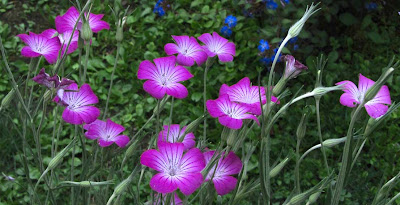 |
| Salvia uliginosa (not "patens" as captioned before!) |
After a massive storm at the start of August - thunder, lightning and hail, causing widespread destruction across our wine regions - there's scarcely been any rain since and the soil is quite parched. This is when late-flowering herbs such as sages and fennel really come into their own, requiring a minimum of attention.
I'm guessing at the variety shown above because it's not one I grew from seed and I've long since lost the label... a common problem! What I can say is that it's pretty vigorous, bordering on the thuggish, and spreads like wildfire unless kept in check ("patens" does mean spreading, apparently). Nevertheless it's great for filling dry areas along walls and you can be ruthless in yanking out unwanted stems.*
Another one we bought at a plant fair, which I think I've correctly identified, is Salvia guarantica 'Black & Blue' - it's name is fairly self-explanatory when you see the dark stems next to those lovely gentian flowers.
It's been in bloom for almost a month now and I shall certainly be on the look out for seeds so that I can raise more plants next year. Some of these more colourful sages are from Mexico and can be a little tender if temperatures dip below -5'C, so it's worth taking cuttings if you have the means to over-winter them. (As we're a bit limited on space, using a cold-frame rather than a greenhouse, I tend to go for the seed option.)
Culinary herbs are also thriving and, thanks to a tip from Monty on Gardeners World, we bought a pot of basil from the supermarket and planted up a number of rooted pieces into our container of tomato plants. He said that the two crops complemented one another, presumably because they appreciate regular watering and feeding, and he's not lying - it's worked really well in our plastic trough and we've enjoyed endless tomato and basil salads!
 |
| Wild fennel fanning the shores of the Gironde |
One herb which is both statuesque and edible is Foeniculum vulgare aka wild fennel, which grows like a weed on verges and along the Estuary. I'm not sure how this plant differs from the giant fennel (Ferula communis) which is more typical in Britain... maybe it's just the Mediterranean version, which is a bit shorter? The one in our garden came from a stray seed and is a couple of meters high, effectively filling the void left by our cypress tree which upped and died earlier this year.
Another maritime herb much in evidence on the cliffs and shoreline is wild marjoram (Origanum vulgare) seen here with its bedfellow, the sea holly (Eryngium maritimum), which appears to grow in chalk as well as on sand.
 |
| Spot the sunflowers..! |
Farmers of sunflowers must be tearing their hair out this year as the wet Spring has led to their fields being invaded by some kind of hedge parsley, as well as the usual crop of thistles and wild datura. Looking up Latin names in my trusty plant book, I was interested to find that hedge parsley (Torilis arvensis) is a member of the same botanical family as fennel and sea holly - ie: Umbelliferae, or carrot!
A farmer's nightmare can equally be a pretty picture to the rest of us and it's great to see such a proliferation of wild flowers. Cycling through vineyards, we pass patches of bright blue on the sunny downland, signifying clumps of wild chicory (Cichorium intybus) which is related to the endive and radicchio used in salads.
There's another cultivated variety we grow in our chalky driveway - Cupid's Dart or Catanache caerulea - which flowers in June and then provides the most stunning seedheads. They have a metallic sheen and in bright sun you can almost believe they're fashioned out of silver or pewter rather than being just light and papery husks... a clever optical illusion.
* Correction, I've just seen a photo of Salvia uliginosa, the so-called 'bog sage', and I'm convinced that this is the one! It starts flowering now and carries on until November, which would be right. Despite being called bog sage, it seems quite happy in a dry spot - give it a damp position and I have a feeling it would probably go mad!















